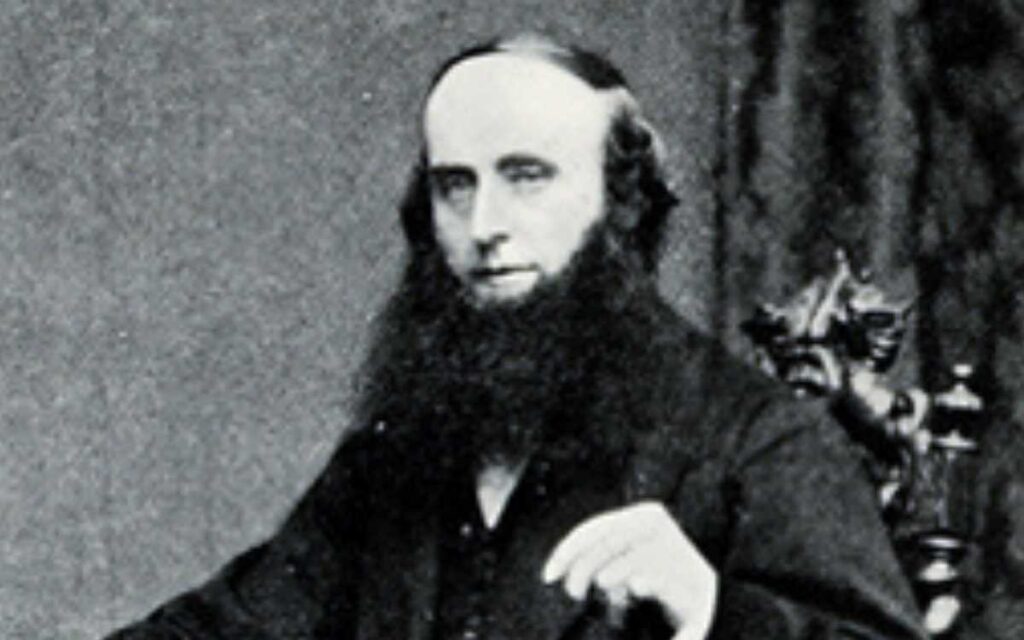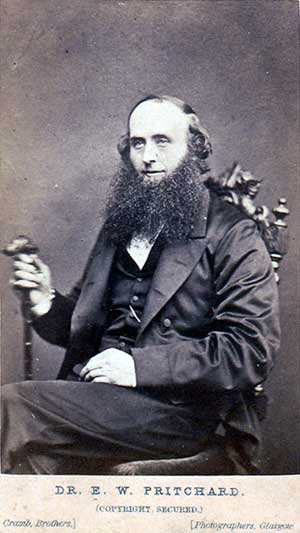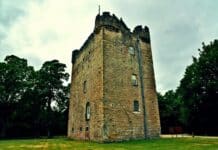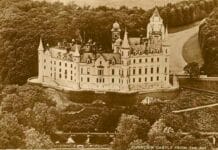Edward Pritchard was the last person to be publicly hanged in Scotland. MJ STEEL COLLINS tells his story…

“You’ll die facing the monument.”
These were the words convicted murders would hear on being sentenced in Glasgow High Court between 1812 and 1865, when public executions were carried out at the entrance to Glasgow Green opposite the court.
The words were in reference to the 300 foot high Nelson’s monument located just inside the Green, the last thing condemned prisoners saw before they met their maker on the scaffold.
No doubt they were the words Edward Pritchard, one of the city’s most notorious murderers heard on being sentenced for killing both his wife and mother-in-law at the end of his trial in Edinburgh High Court in July 1865. He was the last person to be publicly hanged in Glasgow.
A ‘Ladies’ Magnet’
Pritchard’s is a bizarre tale.
Born in Hampshire in 1825, he married Scots born Mary Jane Taylor in 1851 going on to have four children.
A doctor by trade, Pritchard claimed to have studied at King’s College in London and had served in the Royal Navy as a medic.
He quit the Navy not long after his marriage and set up a medical practice in Yorkshire.
An arrogant man, who fancied himself as a ladies’ magnet, Pritchard’s practice failed as he lost patients owing to his bad reputation.
Hoping for a new start, he moved his family to Glasgow.

But he found that his reputation preceded him and he failed to make any headway as a doctor; he attempted to apply for the Andersonian Chair of Surgery at Glasgow University using false documents.
This seems apt behaviour for someone who, as it later emerged, had actually lied about his training.
His ‘medical diploma’ had been bought from the University of Erlangen in Germany, and he had no right to practice as a doctor in the UK.
Life in Glasgow went from bad to worse for Pritchard.
He was regarded as an oddity – telling outlandish tales of his time in the Navy and handing out photos of himself to people he thought ‘worthy’.
His philandering continued, and led to him coming to the attention of the powers that be in Glasgow for the first time in 1863 when one of his maids died in a suspicious house fire when the Pritchards lived in Berkeley Square.
It was alleged that Pritchard had an affair with the maid, winding up making her pregnant. The fire was seen as a little too convenient, but in the end, nothing came of it.
A Compromising Situation
The Pritchards then moved to 131 Sauchiehall Street, engaging a new maid, a 15 year old girl from Islay called Mary MacLeod. Pritchard didn’t waste any time and she became his lover.
They were caught in a compromising situation by Mary Jane Pritchard, though Edward denied anything was going on. Not long after, towards the end of 1864, Mary Jane became ill.
At the same time, her husband had been buying a suspicious amount of chloroform, antimony and Tincture of Aconite at various chemists around Glasgow. Mary Jane eventually left for her mother’s home in Edinburgh, where she made a full recovery, returning home to Glasgow in time for the New Year.
However, Mary Jane fell ill again. Despite her husband supposedly being a doctor, other GPs were called in to treat her, one of them suggesting that she be removed to her brother’s in Cumbria.
After some to-ing and fro-ing, in which Edward said his wife was too ill to be moved, his mother-in-law, Jane Taylor, caught wind of her daughter’s illness, and installed herself, unannounced at the house in Sauchiehall Street.
It wasn’t long before she became ill. A Dr Paterson was called in to treat Mrs Taylor. He found she was dying from antimony poisoning.
Dr Paterson also took the time to examine Mrs Pritchard. Edward Pritchard mentioned that his mother in law was rather fond of taking Battley’s Sedative Solution, and opium based mixture, and was in fact an addict. Mrs Taylor died at 1am on 25 February 1865.
Something Fishy Going On
Dr Paterson smelled a rat, refusing to issue a death certificate. He wrote to the Registrar in Glasgow, stating that Mrs Taylor’s death was highly suspicious.
But it went no further, and Pritchard himself issued the death certificate, citing the cause of death as paralysis followed by apoplexy. This wrong; not only was it not what killed Mrs Taylor, it was the wrong way round, as paralysis can only occur after apoplexy.
Meanwhile, Mary Jane Pritchard continued to suffer ill health, and Dr Paterson kept treating her. She only ever had her worst turns after eating food prepared for her by her husband. Servants partaking of her leftovers fell ill themselves.
Mary Jane died on 18 March 1865. Pritchard again issued the death certificate, this time citing Gastric Fever. Whilst he was organising his wife’s funeral in Edinburgh, an anonymous letter was sent to the Procurator Fiscal, Mr Gemmell, in Glasgow.
Gemmell contacted Superintendent McCall, who ran the city’s Central Police District. They visited the Registry Office and were told of the letter Paterson had sent regarding his suspicions over Mrs Taylor’s demise. McCall was waiting for Pritchard at the train station when Pritchard returned from Edinburgh. He was duly arrested and the funeral halted.
High Levels of Poison
Investigations discovered Mary Jane had extremely high levels of poison in her body, which had killed her. Further investigations led to her mother being exhumed and autopsied.
The results were the same as her daughter’s post mortem. Edward Pritchard was charged with their murders. As the case was complex, it wound up being tried in the Edinburgh High Court, as the Glasgow sessions had ended.
The trial last five days. In the stushie that ran around it, Pritchard tried to blame his maid, Mary MacLeod for the murders. She in turn said that Pritchard had promised to marry her, and had also carried out an abortion when she became pregnant.
It took the jury an hour to find Edward Pritchard guilty on both counts of murder and he was sentenced to death.
The execution took place on 28 July 1865 in front of a packed crowd. The strangeness continued after Pritchard’s death.
The executioner, William Calcraft, had to shave off Pritchard’s long hair and beard and remove his boots so that casts could be taken of his head, face, hands and feet for the Edinburgh Phrenological Society.
The hair was supposed to have been burned. It turned out that Calcraft had kept the hair: he kept a personal memento of every condemned person he executed. He at first refused when told to destroy the hair, but then apparently complied. This and his reputation for botching executions led to him being sacked.
Mysterious Boots and a Pile of Hair
Pritchard was buried in the Glasgow court prison yard. His grave, along with those of other condemned prisoners, was eventually covered over as the High Court was expanded.
It pretty much seemed the end of the story, until 1985 during the renovations. The tunnel leading from the cells to the execution spot was being filled in as it was believed hazardous to the road above.
Just inside the tunnel, a workman found a pair of brown boots, in which was a pile of hair wrapped in paper.
It’s not clear what happened to the hair, but the boots, Victorian button boots, were in good condition and apparently sold on in a pub. It’s believed the hair and boots belonged to Pritchard.







